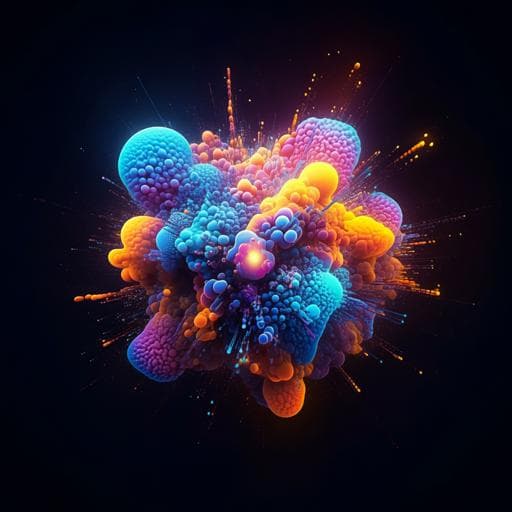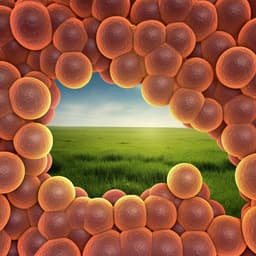
Chemistry
A general design of caging-group-free photoactivatable fluorophores for live-cell nanoscopy
R. Lincoln, M. L. Bossi, et al.
This groundbreaking research introduces PaX dyes, innovative caging-group-free photoactivatable fluorophores that transition into highly fluorescent pyronine dyes upon light activation. Conducted by Richard Lincoln, Mariano L. Bossi, Michael Remmel, Elisa D’Este, Alexey N. Butkevich, and Stefan W. Hell, this method offers a versatile and efficient approach to microscopy, enabling detailed imaging for both fixed and live cells across various techniques.
~3 min • Beginner • English
Introduction
Fluorescence nanoscopy overcomes the diffraction limit to visualize cellular structures at nanometre resolution, relying on fluorophores that can be toggled between off and on states to separate nearby emitters. Photoactivatable or caged dyes, which switch irreversibly upon light, simplify single-molecule methods like PALM and STORM by avoiding specialized buffers and high UV intensities, and enable high-density tracking, background reduction in DNA-PAINT, and channel duplexing in STED. Rhodamines, especially silicon rhodamines, are favored labels due to tunable optics, membrane permeability, photostability, and brightness; however, existing caging strategies (e.g., nitroveratryloxycarbonyl or nitroso protection of amines, or conversion to α-diazoketones) limit substitution patterns, reduce solubility, generate by-products, and yield variable uncaging efficiencies with non-fluorescent side products. A recent Si-pyronine masking via an exocyclic double bond enabled UV-triggered protonation to the fluorescent form but produced a cation prone to nucleophilic addition, limiting applicability. Therefore, compact, caging-group-free, biocompatible photoactivatable dyes are desirable, provided activation is rapid, complete, and by-product-free. Inspired by diarylketone radical photochemistry, the authors designed functionalized 3,6-diaminoxanthones with an intramolecular alkenyl radical trap that, upon one- or two-photon excitation, undergo a light-triggered cascade to form dihydropyran-fused pyronine dyes (PaX), extendable to carbon- and silicon-bridged analogues, covering much of the visible spectrum and suited for live-cell nanoscopy.
Literature Review
The work builds on super-resolution modalities requiring controlled fluorophore switching (PALM, STORM, STED, DNA-PAINT). Prior photoactivatable rhodamine strategies used photolabile caging groups (e.g., NVOC, nitroso) or α-diazoketone transformations, each with drawbacks such as restricted substitution, decreased solubility, by-product formation, and inconsistent uncaging. A silicon rhodamine photoactivation via light-induced protonation of an exocyclic double bond yielded cationic pyronines susceptible to nucleophilic addition, limiting utility. Diarylketones like benzophenone are established photoinitiators with efficient intersystem crossing and reactive triplet diradical states; their photochemistry suggested a route to extend to 3,6-diaminoxanthones as precursors to rhodamines. Photochromic diarylethenes informed the conceptual shift from uncaging (unlocking) to light-induced assembly (locking) of fluorophores.
Methodology
- Molecular design: 3,6-diaminoxanthone core bearing an intramolecular alkenyl radical trap to enable light-triggered radical cascade to a 9-alkoxypyronine (closed-form, CF) fluorophore under one- or two-photon activation.
- Synthesis (general route): (1) Ir-catalysed, chelation-assisted, ortho-selective C–H borylation of diaryl ketone (precursor A) with B2pin2, [Ir(cod)(OMe)], AsPh3 in n-octane at 120 °C; (2) Conversion of boronate ester to aryl bromide using CuBr2/KF/pyridine in DMSO/H2O at 80 °C; (3) Installation of alkenyl substituents via Suzuki–Miyaura cross-coupling (Pd(dppf)Cl2, K2CO3, dioxane/H2O, 80 °C) using RB(OH)2, RBpin or RBF3K; (4) Final deprotection in CH2Cl2/TFA (3:1) at room temperature.
- Compound sets: Initial Si-bridged PaX series 1–7 to explore radical acceptor substitution; bioconjugation-ready PaX variants 9 (PaX480), 10 (PaX525), 11 (PaX560), and 12 (PaX+560, bis-azetidine), each with alkenyl substituents bearing short carboxylate-terminated spacers.
- Photophysical characterization: Absorption/emission spectra, photoactivation kinetics under 405-nm irradiation in phosphate buffer (100 mM, pH 7); LC–MS to assess by-products; quantum yields of activation; stability of CF forms.
- Mechanistic probes: Photolysis in methanol vs aprotic solvents (1,4-dioxane) to examine solvent-dependent protonation; deuterium incorporation in MeOD; effect of deoxygenation on activation rate; radical trapping with 4-hydroxy-TEMPO (adduct detection by MS); radical clock probe (7) to test for ring-opening.
- pH dependence: Photoactivation kinetics of 11 across pH 4.3–9.0; monitor hydrolysis and spectral integrity by LC–MS and spectroscopy.
- Photostability benchmarking: Compare 11-CF against commercial fluorophores with similar spectra under 530-nm irradiation.
- Bioconjugation and labels: NHS esters (13 for PaX560; analogues for PaX480, PaX525, PaX+560), maleimide (14, PaX560), and phalloidin conjugate (15). Live-cell probes: mitochondria-targeting triphenylphosphonium (19), lysosome-targeting pepstatin A (20), HaloTag ligand (21, chloroalkane), and SNAP-tag ligand (22, O-benzylguanine); additional derivatives of PaX480, PaX525, PaX+560 reported.
- Imaging assays: Fixed-cell immunolabelling for STED and PALM (microtubules; nuclear pore complexes with anti-NUP98/NUP107 and nanobodies); actin labelling with 15 in primary neurons; live-cell confocal, two-photon activation (810 nm) and STED with HaloTag constructs; channel duplexing with Abberior LIVE 560 and PaX560-Halo; multiplexing by selective sequential activation of PaX variants; MINFLUX imaging of NPCs with anti-GFP nanobodies labelled with 14.
- Data analysis: Activation rate constants from mono-exponential fits vs power; Pearson correlation for co-localization; MINFLUX localization counts, photon numbers, and precision.
Key Findings
- PaX concept: 3,6-diaminoxanthones with intramolecular alkenes undergo light-induced assembly into dihydropyran-fused pyronines (closed-form, CF) with high fluorescence, photostability, and chemical stability; no detectable by-products by LC–MS in most cases.
- Efficient photoactivation: In phosphate buffer (100 mM, pH 7), Si-bridged PaX 1–6 convert rapidly and completely to TAMRA-like CF products under 405-nm light. Activation quantum yields ΦAct ranged from ~1×10^-2 to 6×10^-2. Activation rate increased with alkene substitution, highest for compound 4.
- Mechanistic evidence: Photoactivation requires protic medium (inefficient in aprotic 1,4-dioxane), shows deuterium incorporation in MeOD at benzylic position, is accelerated by deoxygenation (triplet involvement), and yields a TEMPO adduct in presence of 4-hydroxy-TEMPO, supporting a triplet diradical pathway; radical clock probe 7 showed no cyclopropane ring-opening.
- Spectral tuning and kinetics: Keto forms of 9, 10, 11 absorb at 399, 408, and 414 nm, respectively; CF forms at 480/514 nm (9-CF), 524/564 nm (10-CF), and 558/596 nm (11-CF). Activation rates: 11 > 10 > 9. Closed forms are stable for at least 1 h at pH 7.
- Brightness improvement with azetidines: 12-CF (bis-azetidine) shows emission quantum yield 0.92 versus 0.48 for 11-CF, albeit with slower activation than 11.
- pH dependence: For 11, activation is ~6-fold slower at pH 4.3 versus neutral; small changes up to pH 9. Slow hydrolysis of 11-CF observed at high pH; spectra and product composition unchanged by LC–MS up to pH 8.5. Activation proceeds cleanly in presence of 2 mM mercaptoethylamine or glutathione.
- Photostability: 11-CF outperformed tested commercial fluorophores with similar spectra in photo-fatigue resistance assays (530-nm irradiation).
- Fixed-cell nanoscopy: STED images of microtubules with antibody conjugates of PaX560 (13) and analogues (PaX515, PaX+560) and actin STED with PaX560-phalloidin (15); PALM of microtubules and nuclear pore complexes (NPCs) using maleimide 14 on secondary nanobodies and anti-GFP nanobodies.
- Live-cell targeting and imaging: PaX560-Mito (19) and PaX560-Lyso (20) co-localize with organelle markers after photoactivation with Pearson r ~0.94 (mitochondria) and 0.84 (lysosomes). HaloTag (21) and SNAP-tag (22) labeling in live cells enabled confocal imaging and two-photon activation.
- Protein tag effects: Photoactivation rate increased 7.8-fold for PaX560-Halo (21) upon HaloTag binding; for PaX560-SNAP (22), activation rate increased 11-fold and fluorescence intensity of 22-CF increased 3.3-fold upon SNAP-tag binding versus free dye.
- Two-photon activation: PaX560-Halo (21) activated at 810 nm shows near-quadratic power dependence (exponent ~1.84), confirming two-photon process; compatible with live-cell STED post-activation.
- Channel duplexing: Single-channel sequential imaging enabled by bleaching an always-on dye (Abberior LIVE 560) then activating PaX560-Halo (21) to reveal a second structure.
- Multiplexing by selective activation: Sequential low/high activation doses allow differential activation of PaX variants with distinct activation rates for two-colour imaging in fixed and live cells.
- MINFLUX: Anti-GFP nanobody–14 labelling of NPCs yielded largely complete rings; on average, molecules localized 106 times with 116 photons in the final iteration, achieving mean label precision of 3.7 nm (s.d.).
Discussion
The PaX strategy replaces traditional uncaging with a light-driven assembly that yields compact, uncharged, cell-permeant fluorophores without releasing by-products. By leveraging the triplet-state radical reactivity of 3,6-diaminoxanthones and an intramolecular alkenyl trap, the dyes convert efficiently under one- or two-photon excitation to highly photostable pyronines. This addresses key limitations of caged rhodamines (restricted substitution, solubility issues, by-products) and of previous Si-pyronine activation (nucleophile susceptibility), enabling broad applicability in super-resolution. Tunable activation kinetics and spectral properties through scaffold and auxochrome modification support multiplexed pseudo-colour and multicolour imaging. The dyes perform robustly in standard buffers and in the presence of biological nucleophiles, reducing complexity for SMLM. Enhanced photostability of PaX560-CF (11-CF) benefits high-intensity modalities like STED. The strong performance across fixed and live-cell STED, PALM, and MINFLUX, including two-photon activation to mitigate phototoxicity, underscores the versatility of PaX labels for state-of-the-art nanoscopy.
Conclusion
This work introduces a general design for caging-group-free, bright, and live-cell-compatible photoactivatable dyes based on 3,6-diaminoxanthones bearing intramolecular alkenyl radical traps. Upon one- or two-photon activation, PaX dyes rapidly assemble into highly photostable pyronines. Modulating substitution patterns tunes activation kinetics and spectra for multiplexed and multicolour imaging. Demonstrations across fixed and live-cell STED, PALM, and MINFLUX validate broad utility. The approach is expected to stimulate further development of photoactivatable probes and sensors, with anticipated improvements for MINFLUX and emerging MINSTED nanoscopy.
Limitations
- Photoactivation rate decreases under acidic conditions (~6-fold slower at pH 4.3 versus neutral for PaX560), which may affect applications in strongly acidic environments.
- At high pH, slow hydrolysis of the closed form (e.g., 11-CF) occurs, though spectral properties remain largely unchanged up to pH 8.5.
- The azetidine-substituted analogue (12) shows slower activation than 11 despite higher fluorescence quantum yield, indicating a trade-off between brightness and activation speed.
Related Publications
Explore these studies to deepen your understanding of the subject.







